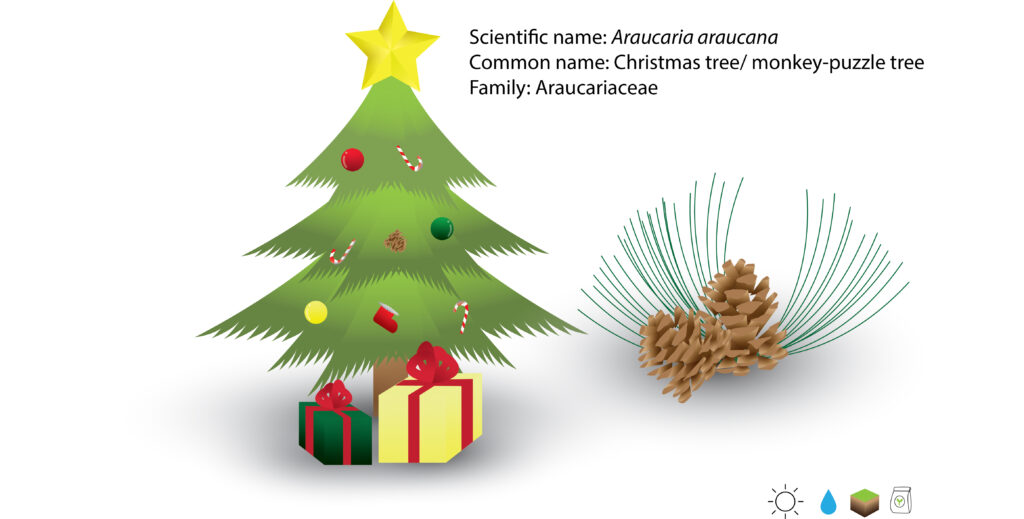The Christmas present is underneath the Christmas tree. Weeks before, the children had written letters to the baby Jesus and slipped them in between the winter windows. Then, the children go to bed while waiting for the surprises from Santa Claus. The tradition of giving presents is not so very old. There was a time when the Christmas tree was unknown in the mountainside. Nowadays, the market offers a Christmas tree suitable for every taste like fir, red fir spruce, and even plastic imitations. The plastic imitations allowed the households to keep and reuse for the next coming Christmas, but it is somehow not able to express the mode of the great festival. This is because the image of a tree brought into a cozy room delighted our ancestors, especially in old-fashioned and romantic times. Therefore, there are still many people who choose to have the Christmas tree from the plantation.
The Christmas tree, which is the Chilean evergreen Araucaria, is also commonly known as the monkey-puzzle tree in the New World. The remark that ‘it would puzzle a monkey to climb it’ gave rise to the common name monkey puzzle. It is scientifically known as Araucaria araucana or Araucaria imbricata that is found under the family of Araucariaceae. It is a huge and impressive tree with its scaly bark. Trees under this family are a remarkable and geologically ancient genus of evergreen conifers that are confined in the wild to South America, Australia, Norfolk Island, New Guinea, and New Caledonia. New Caledonia accounts for thirteen of the nineteen species of the genus. Most are large trees with massive, straight trunks that continue to the apex of the tree, sharply distinct from the crowded, shorter, lateral branches. The leathery leaves are incurved and densely overlapping in some species, flatter, and spreading in others. Like other conifers, there are male and female cones that are found on the same tree. The round and bristly seed cones are developing right at the top of the adult trees.
This Christmas tree enjoyed a fad status in Britain in the 1840s in South America. Young trees have a dome-like shape with interwoven branches. The crown retreats to high above the ground with age, so that old trees resemble long-stemmed parasols. The glossy and dark green leaves are rigid and fiercely prickly. They are considered too large for gardens, but many used to plant them at the park and as street trees. They can grow well in a range of soil types, but they prefer a deep, moist, well-drained soil under the full sun. It needs a climate where the summers are cool and misty. The growth may be quite fast when the conditions suit them. Their globular cones are four to six inches long, which are carried high on the crown of the mature trees. The seeds after the successful fertilization can be propagated in spring. It can grow to eighty feet tall and four feet in trunk diameter.
In addition, some plants are called ‘Christmas tree’ since they are reminiscent of the fir in the shape or appearance. Therefore, common horsetail (Equisetum arvense) and purple loosestrife (Lythrum salicaria) are sometimes referred to as Christmas trees or little Christmas trees. Moreover, the Pohutukawa from New Zealand (Metrosideros excels) is called as New Zealand Christmas tree in the English-speaking world.

Further reading:
Rätsch. C. & Műller-Ebeling. C. (2009). Pagan Christmas – The plant, spirits, and rituals at the origins of Yuletide. Rochester, Vermont.